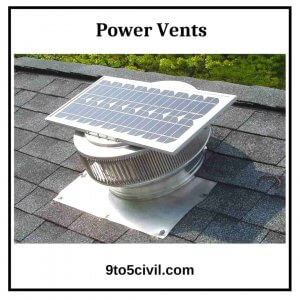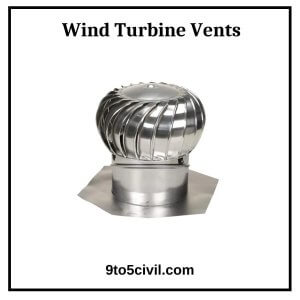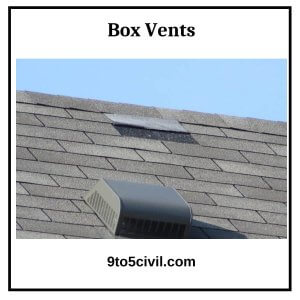Types of Roof Vents
The roof serves as the primary defense for most homes. Types of roof exhaust vents in your metal roofing system ensure that your roof is operating as efficiently as possible. Longevity, lower energy costs, and a healthier home are all made possible through the installation of an effective roof ventilation system.
Since you don’t want your rooftop to be cold in the winter and hot in the summer, it’s best to avoid it at all costs. Both of these issues have the potential to develop into more serious ones, which will be more costly to fix.
There are many different types of roof vents that are available in the market. Roof vents perform the dual function of exhausting old air from the attic and bringing in fresh air (intake).
It’s difficult to know which roof exhaust vent type is best for your home when there are so many options available. In this article, you will get to learn about the different types of roof vents.
How Does Roof Ventilation Work?
In order to avoid condensation in your attic due to overheating, proper attic roof ventilation is essential. An attic or roof space must be ventilated to work, and the two most common ways to do so are:
Natural Types of Roof Exhaust Vents: Natural roof ventilation is used at various places wherever it is suitable. The Air is naturally distributed by the stack effect and the wind effect.
Mechanical Types of Roof Exhaust Vents: In order to generate airflow, a power source is required. Attic pressure rises due to the stack effect, which occurs when warm air rises and creates more pressure. Exhaust is the term for the hot air that exits. Despite this, the hot air can’t be expelled unless there is a way for cooler, lower-pressure air to enter.
As a result of this, your intake and exhaust volume will both be increased by the wind on the outside of your roof. The natural flow of air is created by the combination of intake and exhaust In a properly ventilated attic.
Gable Vents vs. Solar Attic Fan: Which Better for Your Home?
Gable Vents
Gable vents are the cheapest and most natural way to keep your space cool and protect your home from early decay. Gable vents are readily available in the market in unlimited colors, shapes and sizes. , can design a custom gable vent to suit your visual needs and your home’s air needs.
Its basic shapes include triangle gable vents, square louver vents, round attic vents, octagonal gable louvers, half round vent louvers, tombstone gable wall vents and cathedral wall gable vents etc.
Solar Attic Fan
Solar attic fans are designed with special adjustable brackets. which allows the solar panels to be positioned at different angles.
You natural light solar attic fans reduce heat in your attic and make your HVAC system more efficient. You can use it for any type of roof. You solar attic fans can be easily installed on your roof without any electrical wiring or structural modifications. It blends into your ceiling design.
Gable Vent Vs. Ridge Vent
There are two most popular types of roof ventilation. Gable Vents and Ridge Vents. But which one is right for your home? So let’s understand it.
What Is a Gable Vent?
A gable vent is installed at the top of a gabled roof. Gable vents help vent hot air from your home’s attic. which prevents the building from overheating.
What Is a Ridge Vent?
A ridge vent ventilation system runs the length of your home’s roof. It keeps the house cool in the summer and dry in the winter by drawing hot air and moisture out of the attic.
Also Read: What Is Roof Eaves? | Different Types of Eaves Styles | Roof Eaves Repair Cost
2 Types of Attic Ventilation
Each home’s roof ventilation system is unique, and the best types of roof exhaust vents for your home will be determined by your home’s design and airflow.
When it comes to venting your roof, other things to keep in mind are the climate in your region, local building codes, and the design of your ceiling and roof. Types of roof exhaust vents are divided into two main types that are as follows:
1. Exhaust Ventilation
It is a Ventilation through the exhaust pipe. When it comes to venting your attic, you want to get rid of the hot air because it is full of moisture. Mildew and mould growth can occur if hot air is allowed to sit stagnantly.
Indeed, proper types of roof exhaust vents are essential for this very reason. Allowing this hot air to exit your attic is the job of exhaust air vents. The ridge vent is the most common exhaust vent installed near the peak of your roof. Even though they let the hot, humid, stale, moist air out of your house, they are only half of a great roof venting strategy.
2. Roof Intake Vents
Your roof’s health and longevity depend on ensuring that hot air exits your attic space but making sure it does isn’t always straightforward. In order for the hot air to leave, some sort of bouncer is necessary.
An excellent roof venting strategy includes intake ventilation which is used to provide cool, fresh air. Intake vents are installed at the lower part of your roofline to allow this cool air to enter the attic. Intake ventilation aids in the removal of hot air by bringing in cool air over the hot. Exhaust and intake vents should work together in a symbiotic relationship in a perfect world.
Also Read: Catslide Roof | What Is Catslide Roof? | Advantages & Disadvantages of Catslide Roof
7 Types of Roof Vents
In terms of types of roof exhaust vents, the following are the most common options.
1. Hip Vents:
The hip roof vent is similar to ridge vents in design. A ridge vent is not necessary because these roofs are shaped like a pyramid and are steep enough that they don’t need one. After installing shingles over the hip seams, a hip vent is installed. Aesthetically pleasing while still being highly functional, they are a stealthy addition to any office environment.
2. Ridge Vents:
Ridge vents are the newest innovation in roof ventilation technology, and they’ve quickly taken over as the most popular exhaust roof ventilation option for contemporary roofing styles. This is most likely the type of vent system you’ll have installed if you’re replacing your roof.
It is Invisible to the naked eye, these vents are designed to be installed at the peak of a roof slope. Ridge vents are a little more expensive, but they distribute air evenly rather than venting only certain sections.
Consequently, when properly installed, they are one of the most efficient roof ventilation options, which can offset the high upfront cost. Ridge vents and soffit intake venting are commonly used together to achieve the best results.
Also Read: What Is Roof Valley? | Roof Valley Installation | Types of Roof Valleys | Repairing Roof Valleys
3. Off-Ridge Vents:
It’s a lesser-known option to use off-ridge venting. They work in a manner similar to box vents and must be installed in a cutout near the ridge of the roof. The long, thin shape of these vents makes them ideal for removing hot, humid air from your attic. Using these vents in larger attics is not recommended due to their inefficiency.
4. Power Vents:
Electric-powered attic vents are another name for power vents, which, as the name suggests, run on electricity. A wide variety of colors and sizes are available for your roof or gable. These vents are small, round, and low-profile in design. The motor in a power vent turns a fan that pushes hot air out of the attic, reducing humidity. Some power vents come in two varieties:
Your home is directly wired to a thermostat/humidistat to control the operation of hardwired roof vents, which are the most common type of roof ventilation. They have the ability to move a significant amount of air while operating quietly and efficiently.
As opposed to being hardwired, these roof vents are powered by the sun via a solar panel attached to the mount. For roofs that are exposed to a lot of sunlight throughout the day, they are ideal.
Also Read: What Is Clerestory Roof? | Why Install a Clerestory Roof? | Clerestory Roof Cost
5. Wind Turbine Vents:
In addition to being referred to as whirlybirds, wind turbine roof vents date back hundreds of years. You’ve probably seen them in older homes or apartment complexes. The only way these roof vents work is by moving air, not electricity. Due to the spinning of the wind turbine, it pulls hot, humid, stale air out of your attic space and naturally cools it with natural convection.
If you live in an area where the wind is common, wind turbines are the best option for you. Although the vent is effective at speeds of up to 5 mph, this is not a requirement. Both the price and the lifespan of these vents are excellent.
6. Box Vents:
Box vents, in addition to ridge vents, are frequently used for exhaust roof venting. They have a box-like shape and are installed in a hole in the roof, as their name suggests. Your roof may require multiple box vents depending on the size of your home.
This type of vent is ideal for open attic plans because it can be used in conjunction with a soffit vent. Box vents have the advantage of being able to match the color of your shingles, making them less noticeable.
7. Cupola Vents:
To ensure a steady supply of fresh air, cupola vents are positioned at the ridge of a roof.
They are more common on barns, sheds, and other outbuildings rather than homes. They can be expensive, with some clocking in at more than $1,000 for a single cupola vent.
3 Types of Roof Intake Vents
Intake vents function best with other forms of ventilation. They are designed to draw in the fresh air and circulate it through a second system that cools the area. These are some of the most common roof vents that allow for air infiltration:
1. Soffit Vents:
Underneath a roof’s eave or peak, a soffit exhaust vent is an unusual type of vent that must be installed with care. They are constructed of a material that allows humid air to escape. They perform best with a combination of a soffit vent and an exhaust roof vent. It doesn’t matter if these vents don’t save you money, but they do help your air conditioner run more efficiently.
2. Fascia Vents:
Because hip roofs lack much of an edge or eaves to attach to any other type of intake vent, fascia vents are the best option. Hip vents are the ideal complement to these. Although the installation may be different, the ridge vent and soffit vent systems function in the same way.
Also Read:Modified Bitumen Roof | How to Install Modified Bitumen Roofing?
3. Drip-Edge Vents:
Soffit vents work similarly to drip-edge vents, but soffit vents cannot be installed under the eaves of every home. Drip-edge vents can help with this. Intake ventilation is provided by mounting these vents on the drip edge of a roof. For maximum airflow, they’re equipped with a mesh design.
However, when paired with a vent that exhausts the air, these vents are at their most powerful. It’s important to keep in mind that there may not be a clear-cut right or wrong solution when it comes to roof vents. In some cases, what works for your neighbor’s attic may not work for yours, and vice versa.
What is already installed in your attic will ultimately determine the best roof vent configuration. It may also be a matter of personal preference rather than a specific need.
What Are the Benefits of a Properly Ventilated Attic for Your Roof?
During the summer, if your upstairs rooms are too hot, you may attribute the problem to the temperature outside. As a result, your air conditioner is working nonstop to keep you cool. As it turns out, the high temperatures in your house could be the result of poor ventilation in your attic. In addition to the inconvenience of a hot attic, poor attic ventilation also puts you at risk of mold growth.
It’s impossible to know the true cost of a leaking roof until it’s already too late if the attic isn’t properly ventilated. You should be aware of the impact your ventilation system has on your roof and residence. Most homeowners are unaware of this issue until a roofing contractor points it out. This is an extremely important topic, so we’re going to break it down for you.
Since 1990, Bill Ragan Roofing has been providing the Nashville area with high-quality roofing services. Every time we work with a new client, we make sure they understand the value of a properly functioning attic ventilation system. If your attic is not properly ventilated, it is one of the first things we check during an assessment.
What Can Improper Attic Ventilation Cause?
Ice dams are one of the common occurrences when roof ventilation is inadequately given. You will lose everything that matters to you in the most gruesome way imaginable.
However, even though there may not be world-ending destruction if you don’t have proper ventilation in your attic, your roof, your home, and even your lifestyle will be negatively affected. They consist of:
- Dead air in the attic contributes to the poor quality of the air inside the house (summer).
- To cool the second and third floors of your house (if applicable), your overtaxed HVAC systems must work even harder.
- The attic has a lot of moisture (in the form of warm air) in it.
- If you live in a colder climate, you’re more likely to see ice dams during the winter months.
- Rotted sheathing on the roof.
Like this post? Share it with your friends!
Suggested Read –
- Modified Bitumen Roof | How to Install Modified Bitumen Roofing?
- What Is Roof Eaves? | Different Types of Eaves Styles | Roof Eaves Repair Cost
- Porch Foundation | Porch Foundation Options | How to Build a Porch Foundation?
- Catslide Roof | What Is Catslide Roof? | Advantages & Disadvantages of Catslide Roof
- What Is Shear Wall? | Purpose of Shear Wall | Function of Shear Wall | Types of Shear Wall | Advantages &Disadvantages of Shear Wall | Application of Shear Wall
Frequently Asked Questions (FAQ)
Types of Roof Vents:
- Ridge Vents
- Off-Ridge Vents
- Wind Turbine
- Hip Vents
- Power Vents
- Box Vents
- Cupola Vents.
What Is the Best Exhaust Vent for My Roof?
Modern roofing systems typically use ridge vents as exhaust vents. Ridge vents and other exhaust vents like these are provided to get hot, humid, moist stale air out of your home.
What Is the Best Type of Roof Ventilation for Your Home?
The combination of soffit and ridge vents is the best and most efficient way for your roof. Best roof ridge vents provide a uniform distribution of temperature in the roof. Which is installed along the entire length of the horizontal ridge of the roof.
How Much Does It Cost to Install Roof Vents?
Roof vents can cost between $ 300 and $ 650 on average. These costs include labor and materials. It also depends on its type, size, and a number of units. Roof vents can range from $ 10 to $ 500 as they come in a variety of styles.
Flat Roof Exhaust Vent:
Most homes with a flat roof have a Louvard pop vent installed. It expels air from the attic space or allows hot air to be expelled from the attic space by means of an electric fan.
Metal Roof Vent:
A proper Metal Roof Exhaust Vent is required to ensure energy efficiency in a metal roof. Effectively ventilated metal roof helps prevent energy waste and additional cooling costs.
 Skip to content
Skip to content










I enjoy the concepts you incorporated in your content! Thank you for sharing! I am looking forward to reading your other postings.